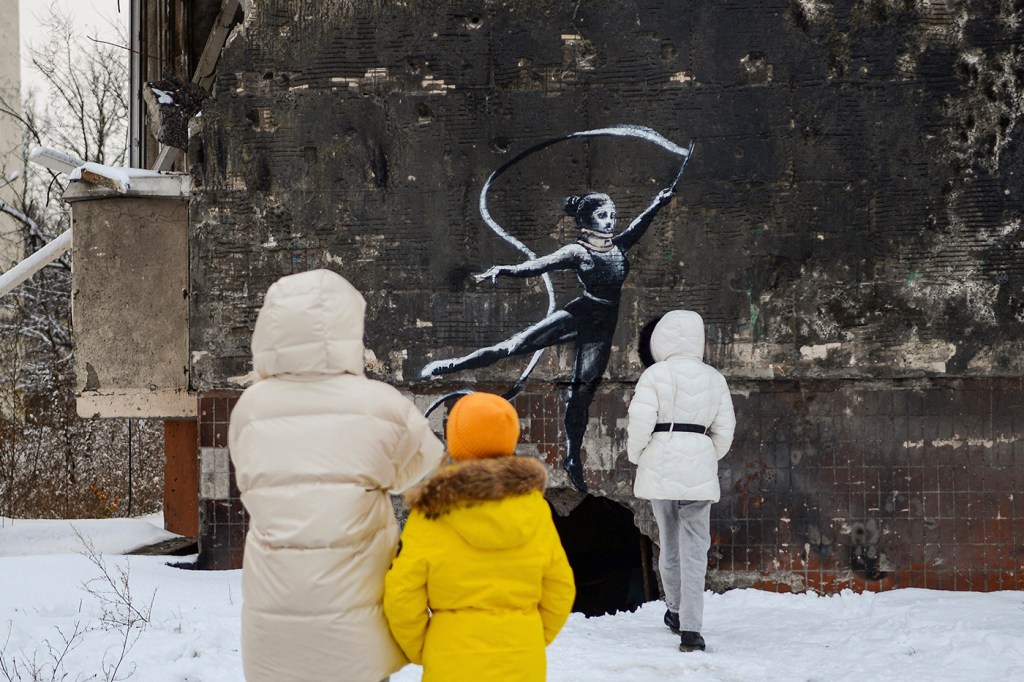How far can British street artist Banksy take his anonymity?

The pseudonymous British street artist last month accused Guess of using his artwork without his permission after they started selling clothes that feature his designs.
In response, Banksy encouraged shoplifters to steal from the Regent Street store in London, writing on his Instagram account: “They’ve helped themselves to my artwork without asking, how can it be wrong for you to do the same to their clothes?”
Banksy has made legal efforts to prevent brands like Guess from using his designs. But there is a major obstacle in doing so: navigating the United Kingdom’s legal system without giving his real name.
How far can Banksy take his anonymity?
There are theories about Banksy’s identity, and we do know a few things about him (or her, or them), like that he most likely hails from Bristol, England. However, confirmation of Banksy’s true identity remains elusive, and the artist’s only point of contact is a company named Pest Control, which, according to their website, “handles the paperwork.”
It’s not uncommon for graffiti artists to work anonymously. Valentinos Mikalef, founder of the mural company Graffiti Arts, says he employs artists who work anonymously or as a collective. For graffiti artists, he says, anonymity can be important in order to not “get into trouble.”
For Banksy, Mikalef says, anonymity is also an important part of his image. “I think he’s definitely a marketer,” he says. “I think it’s all about creating this mystique of who he is, and to have people guessing.”
So is his anti-establishment stance, and his insistence that his work not be used for commercial gain. “He has really actively disavowed copyright throughout his career,” says Alexandra Roberts, professor at the Northeastern School of Law. “He has written, ‘copyright is for losers.’ He says on the Pest Control website that his artwork can be used, but not sold.”
In this respect, he hasn’t been as successful as he has been in staying anonymous. Traveling exhibits charge entry fees to view Banksy’s designs, and a simple Google search shows many other options for purchasing prints of his designs.
But “there are hurdles for Banksy” to legally protect his work and to prevent something like the Guess controversy from happening again, says Roberts. “It’s really messy.”
Banksy could sue for Guess copyright infringement, since the brand is using his work without his permission. But with copyright law, “there are a number of steps in that process where there is at least a risk of revealing his identity,” Roberts says.
In the United States and the United Kingdom, an artist’s work is automatically protected by copyright upon its creation. However, in order to sue for copyright infringement in the U.S., their artwork needs to be registered. Not so in the U.K., but in any case, “when you sue, it’s hard to sue without revealing your identity,” Roberts says.
Instead, Banksy has pursued another option in the U.K.: trademarking. Unlike copyrighting, trademarks protect brand logos, and are usually registered by companies. Banksy has registered trademarks in the U.S. for some media, Roberts says, although this was controversial, as the U.S. Patent and Trademark Office doesn’t usually allow this.
He has also registered trademarks in the U.K. under his company Pest Control, and this month, the E.U. Board of Appeals reversed a 2020 decision that said these trademarks could not be registered anonymously.
This ruling could mean Banksy has a legal case against Guess, Roberts says. “If there are trademark registrations for the images being used here, then yeah, this is a winnable case,” she says. However, she says, it would be difficult to file suit without revealing his identity at some point.
Banksy also may have a case based on the law of “passing off,” “where someone pretends to be someone famous,” says Stephen Dnes, associate professor in law at Northeastern University London. “But to get that to work, he’s going to have to reveal who he is.”
Even if he stops fighting the commoditization of his artwork, as someone who has an Instagram account, there are measures he may need to take to stay anonymous. Dnes says that in theory, it is possible to discover someone’s identity using their IP address and a combination of other factors, and this is perfectly legal in the U.K. However, simply using a VPN could keep him safe.
“No one’s actually done it,” Dnes says. “The question arises, has Banksy just been really good at this? Or is it actually a demonstration that it’s quite hard to crack identity online?”
The greatest potential for disaster, though, likely comes from the people that Banksy surrounds himself with.
“He’s done a very good job of not creating a paper trail,” says Matt Carroll, professor of the practice at Northeastern and an investigative journalist. The key to Banksy’s anonymity, Carroll says, is “Really, really good lawyers.”
However, “There’s so many ways it can come undone really, really fast.”
If Carroll were to investigate Banksy’s identity, he says, and wasn’t able to find a paper trail, he would then follow rumors, track down old classmates, and talk to art dealers and galleries that have been known to work with Banksy.
Banksy can have people who work with him sign non-disclosure agreements; however, as Dnes says, “You can’t put the genie back in the bottle.” If someone comes forward with Banksy’s identity, “by that stage, it’s too late.”
For media inquiries, please contact media@northeastern.edu.






